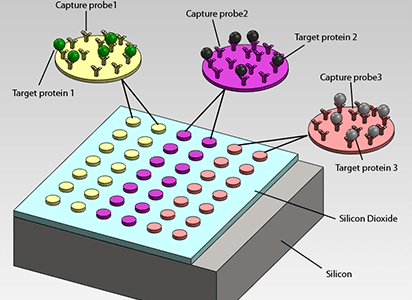Abstract
The present disclosure relates to methods of measuring target nucleic acids by using coded molecules and analysis thereof by translocation through a nanopore. Generally, coded molecules pertain to a target polynucleotide dependent modification. The modified coded molecule is identified by isolating the modified coded molecules from the unmodified coded by testing a change in the signal pattern of the former – the coded molecule when analyzed through the nanopore.
What is claimed is
1.A method of detecting a target polynucleotide, comprising: a) contacting a coded molecule with a target polynucleotide, the target polynucleotide including proximal first and second regions, wherein the coded molecule contains: (i) one or more block polymer regions, and (ii) a target probe has the capability of hybridizing to the second region of the target polynucleotide; b) hybridizing a ligation probe to the target polynucleotide, wherein the ligation probe hybridizes to the first region and the target probe hybridizes to the second region of the target polynucleotide such that a terminus of the ligation probe and a terminus of the target probe are contiguous; c) translocating the coded molecule through a nanopore and measuring a signal pattern associated with the coded molecule.2. The method of claim 1, further containing the step of rendering the coded molecule single-stranded ahead of translocation through the nanopore.
3. The method of claim 1, further containing comparing the measured signal pattern to a signal pattern of an unmodified coded molecule, wherein a difference in the determined signal pattern of the modified coded molecule compared to the signal pattern of the unchanged coded molecule demonstrates the presence of the target polynucleotide.
4. The method of claim 1, further containing associating the measured signal pattern to the target probe.
Background
The determination of target nucleic acids has many critical applications in pharmaceuticals and environment monitoring. To provide consistency, speed, and specificity in measuring multiple target polynucleotides, various multiplexing techniques have been developed in which detection is implemented in a single reaction. Multiplexing approaches on the strength of microarrays and microbeads that combine powerful nucleic acid amplification strategies with the massive screening capability to provide high throughput capacity along with high level of consistency, sensitivity, and specificity.
Microarrays and microbeads are particularly suitable for detecting single nucleotide polymorphisms, which represents one of the largest sources of diversity of organisms. Some single nucleotide variations are directly related to phenotypic traits of interest, such as disease susceptibility. However, most single nucleotide polymorphisms are neutral. But because most biological processes involve the interaction of numerous genes, even neutral sequence variations served as useful markers in linkage maps for researching phenotypes having an underlying multigenic basis. The rising number of SNPs, for example the SNP database maintained by NCBI, provide a rich resource for genetic analysis on the basis of sequence polymorphisms.
Despite the advantages of microarray and microbead based nucleic acid detection systems, these methods still have shortcomings. For example, the need to enlarge the target nucleic acid in many applications represents a drawback because of variability in amplification efficiency. Since microarray and microbead techniques typically compare signal intensity between samples for determining positive or negative results, variability in amplification reactions can adversely affect the detection of the absence or presence of a particular target nucleic acid in these assays. In addition, microarray and microbead based detection typically depend on summing of signals from a population of probe-target nucleic acid interactions, which limits the sensitivity of the assay formats.
In the view of the foregoing, it is desirable to have alternative techniques for detecting nucleic acids, where the detection technique is less susceptible to variation in amplification efficiency, displays a high level of sensitivity, and is adaptable for multiplexing reactions to detect SNPs.
Summary
The present disclosure associates with the use of nanopores to detect target polynucleotides. The methods involve use of coded molecules having an related target probe that specifically recognizes a target polynucleotide; modifying the coded molecule with the modifying agent provided where the modification is reliable on presence of the target polynucleotide; and measuring the modified coded molecule by translocating it through a nanopore.
Generally, the method contains contacting a coded molecule with a target polynucleotide, wherein the coded molecule comprises one or more block polymer regions and a target probe capable of hybridizing to the target polynucleotide. The mixture of coded molecule and the target polynucleotide is treated with a modifying agent that modifies the target probe if the target polynucleotide is hybridized to the target probe. In the absence of a hybridized target polynucleotide, the modification of the target probe, and thus modification of the coded molecule, does not occur efficiently. The coded molecule is then translocated through a nanopore and interrogated to detect a signal that is reflective of the polymer characteristics of the block polymer region. In some embodiments where there is a modification of the coded molecule, the modification can alter the signal pattern displayed by a coded molecule such that an altered signal pattern is indicative of the presence of the target polynucleotide. The detected signal pattern is also utilized to identify the specific coded molecule and its related target probe, and thus the specific target polynucleotide detected. In some embodiments, the modified coded molecule can be isolated from unmodified coded molecules on the basis of the target polynucleotide dependent modification, and the isolated coded molecule translocated through a nanopore to measure a signal pattern, which can then be correlated to a specific coded molecule and therefore the specific target polynucleotide detected in the reaction.
Note:
NCBI: Short for the National Center for Biotechnology Information, the NCBI was established on November 4, 1988, as a division of the National Library of Medicine (NLM) at the National Institutes of Health (NIH). As a national resource for molecular biological information, the mission of NCBI is to develop new information technologies to assist in the understanding of fundamental molecular and genetic processes that control health and disease.


 Sample Submission Guidelines
Sample Submission Guidelines